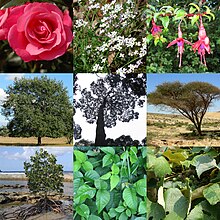Rosids
| Rosids Temporal range:
| |
|---|---|

| |
| Various modern rosid species | |
| Scientific classification | |
| Kingdom: | Plantae |
| Clade: | Tracheophytes |
| Clade: | Angiosperms |
| Clade: | Eudicots |
| Clade: | Superrosids |
| Clade: | Rosids |
| Orders[1] | |
| |
The rosids are members of a large
The clade is divided into 16 to 20
Fossil rosids are known from the Cretaceous period. Molecular clock estimates indicate that the rosids originated in the Aptian or Albian stages of the Cretaceous, between 125 and 99.6 million years ago.[5][6]
Today's broadleaved forests are dominated by rosid species, which in turn help with diversification in many other living lineages. Additionally, rosid herbs and shrubs are a significant part of arctic/alpine and temperate floras. The clade also includes some aquatic, desert and parasitic plants.[7]
Name
The name is based upon the name "
Three different
Relationships
The rosids and Saxifragales form the superrosids clade.
Classification
The rosids consist of two groups: the order Vitales and the eurosids (true rosids). The eurosids, in turn, are divided into two groups: fabids (Fabidae, eurosids I) and malvids (Malvidae, eurosids II).[10]
Orders
The rosids consist of 17 orders. In addition to Vitales, there are eight orders in fabids and eight orders in malvids. Some of the orders have only recently been recognized.[10] These are Vitales,[12] Zygophyllales,[13] Crossosomatales,[14] Picramniales,[15] and Huerteales.[16]
Phylogeny
The
| rosids |
| ||||||||||||||||||||||||||||||||||||||||||
The nitrogen-fixing clade contains a high number of
References
- .
- ^ PMID 19223592
- JSTOR 3647306
- ISBN 978-0-87893-817-9
- PMID 14766971
- PMID 21628193
- PMID 29665035.
- ^ Reveal, James L. (2008), "A Checklist of Family and Suprafamilial Names for Extant Vascular Plants", Home page of James L. Reveal and C. Rose Broome
- PMID 19292928
- ^ a b c d e f Stevens, Peter F. (2001), Angiosperm Phylogeny Website
- JSTOR 25065865
- ^ Reveal, James L. (1995), "Newly required suprageneric names in vascular plants", Phytologia, 79 (2): 68–76 See p. 72
- ISBN 978-0-19-854559-0
- ISBN 978-3-540-32219-1
- ISBN 9783874291606
- S2CID 12887261
External links
 Media related to Rosids at Wikimedia Commons
Media related to Rosids at Wikimedia Commons
